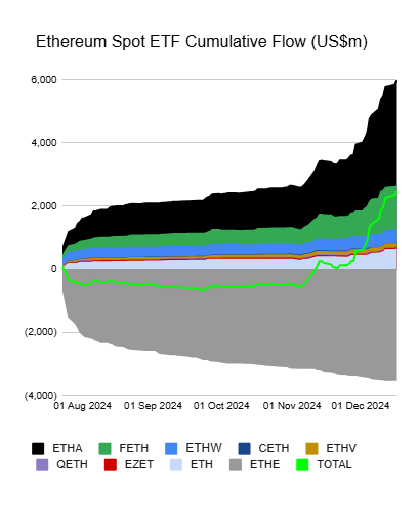BlackRock’s iShares Ethereum Trust now holds more than 1M Ethereum (ETH), solidifying its position as the second-largest ETF holder after Grayscale. The fund was also the most aggressive buyer in the past year, while other funds held under 100K ETH even after accumulation.
BlackRock’s iShares Ethereum Trust (ETHA) holds a total of 1.025M ETH, breaking the milestone of 1M ETH after aggressive buying. The recent buying followed a previous series of ETH purchases in September, while the market drifted sideways.
With the latest purchases, ETHA now holds over $3.9B in ETH, becoming the largest competitor to Grayscale’s Ethereum Trust. Grayscale still owns 1.96M ETH after divesting and transforming some of the holdings. After the initial sell-off, Grayscale retained its holdings, but BlackRock is the most actively bought fund, with the potential to catch up.

BlackRock was behind the inflows in the past few weeks, where the ETF started attracting more aggressive investments after a period of selling.
Ethereum-based ETFs hold a less significant amount of ETH compared to BTC buyers. ETH still has a supply of over 120.4M tokens, of which around 80M are in the hands of whales and investors. The recent ETF buying leads to passive holding of the tokens, though the possibility of a staking ETF is seen as an alternative.
BlackRock surpassed smaller funds with recent buying
BlackRock now owns more than 3x of the ETH held by the Ethereum Foundation. The fund is still surpassed by Robinhood with 1.4M ETH and other exchanges and entities that require large reserves. The BlackRock holdings are not represented by a single wallet, as they are held in custody through Coinbase Prime.
BlackRock is the first fund in 2024 to achieve the 1M milestone through direct buying and inflows. The Grayscale haul was a legacy of its previous exchange-traded product (ETP). In the past few months, BlackRock surpassed other funds both in terms of daily purchases and long-term accumulation, repeating its buying pattern from its acquisitions for the BTC ETF.
The recent level of 1M ETH was achieved within weeks, as BlackRock accelerated its buying in December. The recent buying expanded the holdings from a baseline level of 606M ETH.
The only other fund with rapid expansion is Fidelity, which holds a total of $1.63B in ETH. The buying of BlackRock’s iShares is notably steeper compared to other ETF issuers.
ETF as a whole still holds a relatively small reserve of ETH compared to other entities. However, accelerated buying may be a signal that ETH is catching up as a mainstream asset.
In 2024, ETH failed the prediction that the ETF would take it to a price zone above $4,000. Despite the mainstream buying, ETH is still performing as a utility coin. The expectations for a higher price range are not entirely abandoned, allowing for a new wave of ETH mania for both crypto insiders and ETFs.
BlackRock is also invested in the wider Ethereum ecosystem, as the provider of its BUIDL token. BUIDL is used to provide collaterals and locked value, due to its conservative mix of assets. BUIDL is spreading to Ondo Finance and other DeFi entities, retaining a total supply of 426K tokens.
ETH remains under $4,000
ETH returned to $3,895.45, losing its recent gains above $4,100. The effect of ETF buying is relatively symbolic, as there are entities with a bigger capacity to lock in ETH. The ETH market cap dominance is also lower, down to 12.7%, the lowest level since 2020.
ETH’s open interest has also stagnated, expecting a clearer message on the asset’s direction. For the past year, Ethereum proved indispensable for the DeFi ecosystem, still locking in over $77.17B.
Ethereum also got a boost from the recent printing of up to 22B USDT, which moved into the market in the form of ERC-20 tokens. Ethereum once again became the biggest carrier of stablecoins, surpassing TRON.
The mix of sideways trading and promising on-chain data suggest ETH may be undervalued and still capable of a breakout.
From Zero to Web3 Pro: Your 90-Day Career Launch Plan










